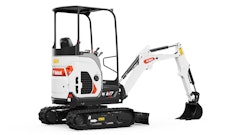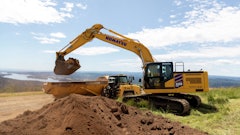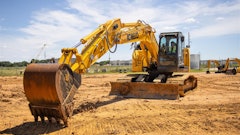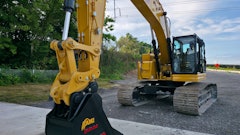Transcript
Over the last few years, the work on electrifying construction equipment fleets has really caught on fire....that's probably a poor choice of words. It’s all the buzz. You get the point.
Some of the equipment makers have been a bit more talkative about the work they’re doing on this front than others, and of those, Komatsu has been one of the most talkative. A big reason for that is Komatsu sees electrification and this coming era of electric equipment as an aspect of the industry that it not only has a head start in—it was the first to bring a hybrid hydraulic excavator to market in 2008 with the launch of the PC200-8—but as an opportunity for market dominance.
And the company is actually readying to launch its very first fully-electric, battery-powered excavator. Not only that, this excavator will be powered by a swappable battery system, developed by Honda.
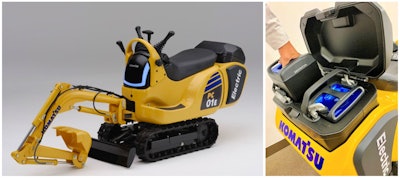
And here it is. The PC01E.
Now if you’re underwhelmed at the sight of this thing—despite the fact that it’s the world’s smallest hydraulic excavator that you can actually ride on, which is pretty cool—before you walk away from your screen disappointed, let me explain why this thing is such a significant development in the whole electric equipment landscape.
Specs
First up, let’s talk specifics. What is this tiny excavator and why who is using it?
The PC01 is actually one of three “micro” excavators that Komatsu sells in overseas markets. As the name suggests, this little electric digger is based on the PC01, a 3.5-hp machine that has a digging depth of just about 3.5 feet and weighs in at a whopping 661 pounds.
A few more fun facts to drive home just how small this thing is, it’s fuel tank is 1.2 gallons, it has a hydraulic flow of 2.7 gpm, and its ground pressure is only 2.4 psi.
The PC01 is sold in the Asia and Oceania markets and because of its small size—Komatsu says it fits in the back of most compact pickup trucks—and low ground disturbance, it’s typically used in pipe-laying, gardening, agriculture and livestock applications. The other two models are the PC05 and the largest micro excavator, the PC09. The PC09 is 9.1 hp, can dig down to 4 feet, 10 inches, and weighs a full ton.
Komatsu hasn’t shared any specifics on the electrified PC01E, but precedent tells us it will very likely match its diesel predecessor in performance and capability.
Notably, while the machine is now electric, its bucket, arm, boom and blade are still hydraulically driven. But it does look like the electric conversion and the addition of these Honda battery packs have added to both the machine’s weight and its footprint.
If you take a look at the PC01 and the PC01E side-by-side, the battery pack has basically been tacked on to the back of the machine. Speaking of that battery pack, let’s dig into what makes these Honda batteries so special. Honda debuted its Mobile Power Pack batteries back in 2018 at the Consumer Electronics Show.
Each MPP battery reportedly holds up to 1 kilowatt hour of charge. For comparison’s sake, let’s look at the other battery development project that Komatsu has announced with, Proterra.
Komatsu's Other Electric Excavator Project
Proterra is based out of California and is a well-established player when it comes to commercial battery technology. Up until its announced partnership developing batteries for a midsize Komatsu excavator prototype, the bulk of the companies work has been on electrifying commercial trucks and buses.
In 2017, one of Pro terra’s 600 kWh battery enabled a bus to travel 1,102 miles on a single charge. For the Komatsu partnership, it’s probably safe to assume that whatever battery Proterra is developing will be 600 kWh—or a configuration of multiple 600 kWh batteries—if it’s going to power a midsize excavator for 8 hours each day.
Furthering the comparison into the automotive world, Tesla’s model S has a 100 kWh capacity and GMC’s new Hummer EV will have a 200 kWh capacity. So, with numbers like 600, 200 and 100 kWh, the 1 kWh capacity of Honda’s MPP battery packs might sound like a joke. But when it comes to battery packs, we have to avoid the temptation to get too caught up in large numbers.
How Big is a Big Battery?
That’s because—as the hour in the term suggests— kWh is a measurement of capacity not power. To put it in simple terms, 1 kWh of capacity is enough to power a 1,000 watt appliance or device for one hour. So, the big thing to pay attention to is wattage. If you run anything pulling less than 1,000 watts, you’ll have power to that device more than one hour. If you go above, you’ll have power for less than an hour.
But, in the grand scheme of things, 1 kWh is still not a lot. That’s why Honda introduced the packs with applications like mobility scooters, UTVs, side-by-sides, motorcycles and other small vehicles in mind.
In fact, if you look at the PC01E more closely, you’ll see that 1 kWh is not enough to feasibly power even this tiny machine for a reasonable amount of time. That’s why the power pack Komatsu is implementing here holds two MPP packs for what will likely be 2 kWh of available power per charge. It’s unclear from a wattage standpoint what the PC01E, which retains its hydraulics, would require or be comparable to.
But again—we’re talking about capacity, not capability. We know these battery packs are powerful enough to power this machine, we just don’t know for how long. Unfortunately, that is the primary concern of most contractors and equipment operators when it comes to batteries. How long before I have to stop working and charge the thing?
But that’s exactly why these MPP packs are so important.
Swap 'Til You Drop
This talk of capacity brings us to the big push behind development of MPP battery packs—they’re swappable.
They’re not designed for maximum capacity. They’re designed to retain the immediate availability of energy that we currently only enjoy from diesel and gas-powered equipment. When the PC01E runs out of juice, you don’t charge it back up.
Based on what Komatsu and Honda are laying out here, you’d have no fewer than 4 MPP battery packs. When two are in use on the machine, the other two are charging. When you run out of juice, you swap the two fully charged packs in and continue working. But again, clearly 1 kWh battery packs are not going to be the full realization of that vision.
The fact that these packs are 1 kWh per charge is precisely why Komatsu is implementing them first on literally their smallest possible machine.
Two Paths Forward
What’s clear—and this is both important and encouraging—is that Komatsu sees two paths two machine electrification. One is with machines that have huge capacity batteries that are charged at the end of each day. The other is with swappable battery packs.
The fact that Komatsu sees the value of both approaches and is partnering with two separate companies with distinct strengths to explore those approaches to the fullest extent, illustrates how seriously the company is taking electrification. Plus, by the time everything is said and done, it’s unlikely that one of those solutions will fully win out over the other.
There’s a good chance that we’ll see machines powered by swappable forms of energy, be it batteries or even hydrogen fuel cells, while others are powered by large, stationary battery arrays.
Going even further into that, different machines and even different applications and project environments are going to cal for different development and engineering solutions. Komatsu clearly knows that and are going at this problem from both ends. But this Komatsu/Honda team up is much more than the PC01E.
The two companies say they’re working on not only bringing swappable MPP batteries to more types of construction equipment and civil engineering tools, but that they’re also working to ensure that you’ll be able to swap these MPP batteries between any machine or device that supports them.
That means if you do build a collection of MPP batteries, you’d be able to swap them between your excavator, your tools, your UTV and maybe even your motorcycle. Komatsu and Honda say they plan on launching the PC01E before the end of March 2022. As part of the larger push behind the MPP battery platform, the two companies have also said that they will continue to study and verify the platform’s use in real world applications and projects.
Komatsu hasn’t said where the PC01E will be sold, but given where its diesel counterpart is currently sold, it likely won’t come to North America.
But like I said at the top, it’s not so much the machine that’s important here. This partnership with Honda and the fact that these two giant companies are working on solving swappable battery packs for construction equipment is a huge development and could have major impacts down the line.





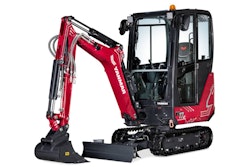

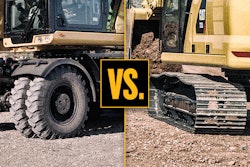
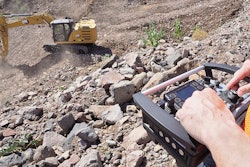





![Hcm Ax Landcros Dual Branded Logo[25]](https://img.forconstructionpros.com/mindful/acbm/workspaces/default/uploads/2025/11/hcmaxlandcros-dual-branded-logo25.Qhg3vUCjoK.jpg?ar=16%3A9&auto=format%2Ccompress&bg=fff&fill-color=fff&fit=fill&h=135&q=70&w=240)
